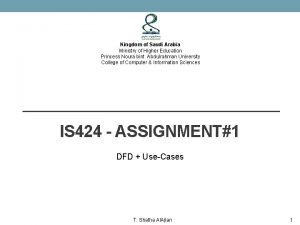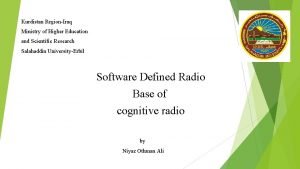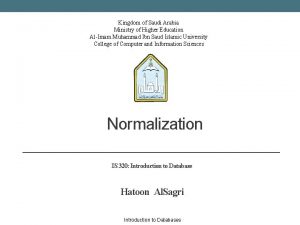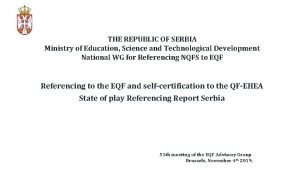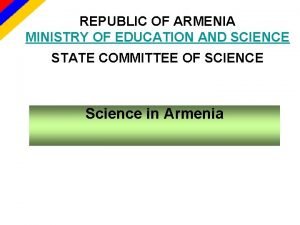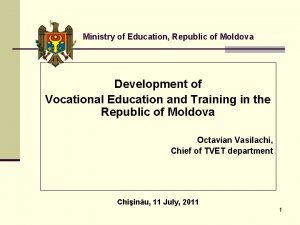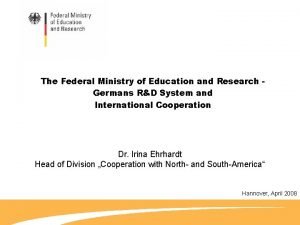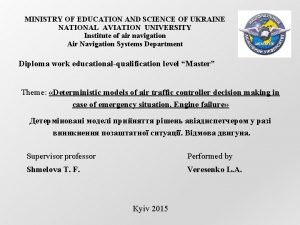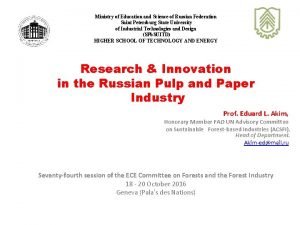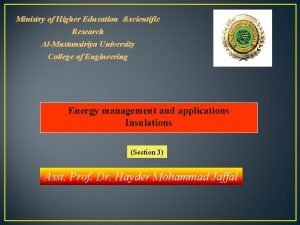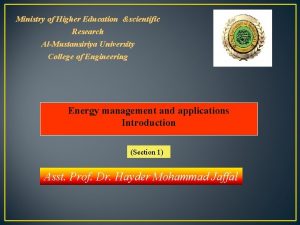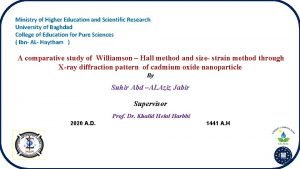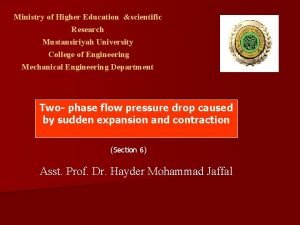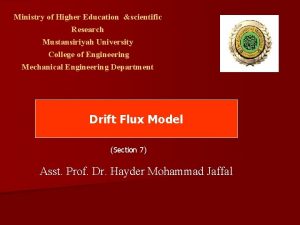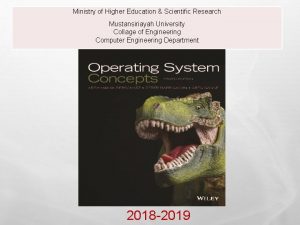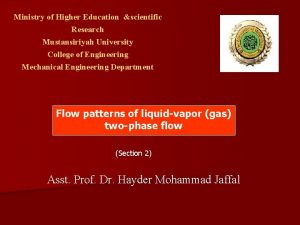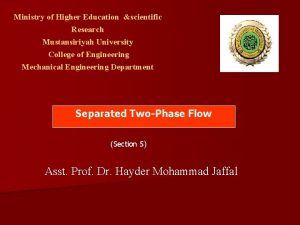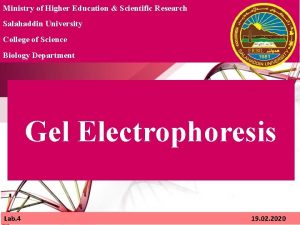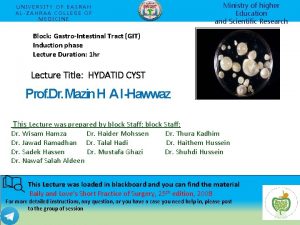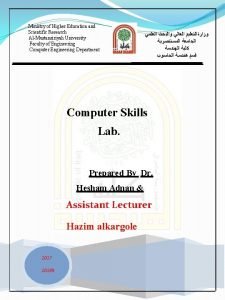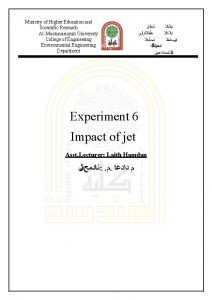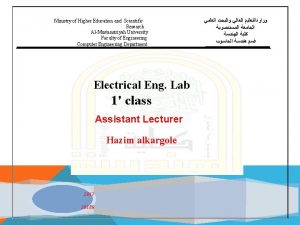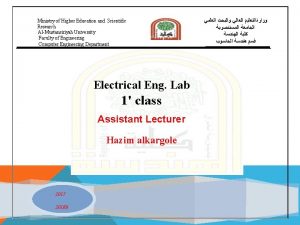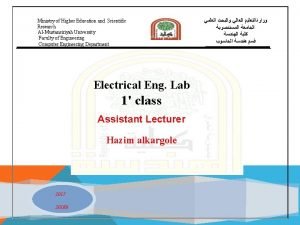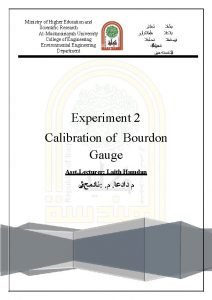Ministry of Higher Education scientific Research AlMustansiriya University




































- Slides: 36

Ministry of Higher Education &scientific Research Al-Mustansiriya University College of Engineering Energy management and applications Thermal Energy Storage Systems (Section 6) Asst. Prof. Dr. Hayder Mohammad Jaffal

1 - Introduction Thermal energy storage (TES) is generally defined as the temporary storage of energy for later use when heating or cooling is needed. For heating applications, heat storage systems are used with energy stored at high temperatures [above 20°C (68°F)]. For cooling applications, energy is stored at low temperatures [below 20°C (68°F)]. The concept of TES is not new and was used a few centuries ago to cool churches using blocks of ice that were stored in the cellar. Recently, TES technology has been shown to be effective especially in reducing the operating costs of cooling plant equipment. By operating the refrigeration equipment during off-peak hours to recharge the storage system and discharge the storage during onpeak hours, a significant fraction of the onpeak electrical demand energy consumption is shifted to off-peak periods.

Cost savings are realized because utility rates favor leveled energy consumption patterns. The variable energy rates reflect the high cost of providing energy during relatively short on-peak periods. Hence, these rates constitute an incentive to reduce or avoid operation of the cooling plant during on-peak periods by the cool storage system. A large differential between on- and off-peak energy and peak consumption rates generally makes cool storage systems economically feasible. Some electric utility companies actually encourage the use of TES systems to reduce the cost required to generate on-peak electric power. Indeed, the need to build new generation plants in order to meet the demand during on-peak hours can be eliminated by promoting the use of off-peak power. Thus, utilities have initiated different rate structures to penalize the use of electric power during on-peak periods.

In addition to the differential charges for on-peak versus off-peak energy rates, the utilities have imposed demand charges, based on the monthly peak demand. These demand charges are intended to recover fixed costs such as investing in new generation plants, and transmission or distribution lines. In the United States, it is estimated that 35 percent of the electric peak demand is due to cooling. Therefore, the use of TES systems can be a good alternative to delay the use of chillers to meet space cooling especially for commercial buildings. TES systems can also be used to reduce the size and thus the initial cost of the cooling equipment especially in applications where peak loads occur only for a limited period during a year such as churches. For instance, a church can have a peak cooling load of 300 k. W over a three-hour period that occurs once a week. Instead of using a chiller of 300 k. W to operate for three hours in order to provide the required 900 k. Wh of cooling load, a 90 -k. W cooling system can be installed.

The same cooling load (900 k. Wh) can then be produced by operating the 90 -k. W cooling system for a longer period (at least a 10 -hour period to account for any storage losses). Due to compressor efficiency and storage losses, cooling plants with TES systems may actually consume more energy that cooling plants without TES systems. However, TES systems if designed and controlled properly can reduce the overall operating costs of cooling plants. To determine the potential operating cost reduction, the auditor should carefully consider the various factors that affect the design and operation of TES systems.

2 - Types of TES Systems Thermal energy storage can be achieved by two mechanisms: 1. Sensible Heat Storage: Sensible energy storage by increasing (for heating applications) or decreasing (for cooling applications) the temperature of the storage medium (water for instance) 2. Latent Heat Storage: Latent energy storage by changing the phase of the storage medium (phase change materials, PCM, eutectic salt solutions, or ice–water mixtures) 3. Thermochemical Energy Storage: Thermo-chemical storage (TCS), or Thermochemical Heat Storage (THS), requires a reversible chemical reaction. THS is divided into three processes: charging, storing and discharging.

For cooling applications, there are several types of TES systems that have been installed in various commercial buildings and industrial applications. Among these TES systems are: a) Chilled water storage systems: These systems typically consist of tanks where chilled water (temperature above freezing point) is stored before it is used during off-peak periods. There is no change of phase for the water in these systems and thus they can store a limited density of energy. Water is selected because it has the highest specific heat of all common materials (4. 18 k. J/kg×°C). Typically, a tank volume varying from 0. 09 to 0. 17 m 3 is required to store 1 k. Wh of energy using chilled water.

b) Eutectic salts: In these systems, a solution of salts is used to store energy at low temperatures. The advantage of these systems is that temperatures below 0°C can be achieved before the solution is frozen. In addition, some salts have heat of fusion comparable to that of ice. It should be noted that the solution of salts needs to be mixed in a controlled ratio to ensure that the mixture melts completely and has the same composition in both liquid and solid phases. For eutectic salts, the volume requirement for the storage tank is estimated to be 0. 05 m 3/k. Wh. c) Ice storage systems: In these systems, the water is transformed into ice which is stored in tanks. Therefore, the water can be present in the form of two phases (liquid and solid) inside the tank. Typically, the ice is made during the off-peak periods (charging) and is melted during on-peak periods (discharging). Ice storage systems have a higher energy density compared to chilled water systems. Thus, the volume of the storage tank required for ice systems is significantly less than that for chilled water systems (almost onefourth).

In addition, ice storage systems allow for innovative HVAC system design such as cold air distribution systems which have lower initial costs compared to conventional distribution systems. Common ice storage systems include: 1) Ice harvesters: In these systems [Figure 1(a)], thin ice layers are formed around vertical plates evaporator) that are sprayed with water pumped from the tank. The ice layers are harvested to the storage tank by circulating hot gases through the evaporator. The ice mixed with water is stored in the tank to obtain what is often referred to as ice slurry. The volume requirement for the storage tank used in ice harvesters is about 0. 025 m 3/k. Wh. 2) Internal melt ice-on-soil storage systems: In these systems [Figure 1(b)], direct expansion coils are fitted inside the storage tank which is filled with water. A brine solution (mixture of water and ethylene glycol) is typically circulated through the coils with a temperature in the range of – 6°C to – 3°C. In the charging mode, ice layers are formed around the coils.

In the discharging mode, the ice is melted by circulating a warm brine solution in the coils to becooled in order to provide space cooling. The volume of the storage tank required for internal melt ice-on-coil systems varies from 0. 019 to 0. 023 m 3/k. Wh. 3) External melt ice-on-coil storage systems: They are similar to the internal melt ice-on-coil system in that the ice is made around coils filled with brine solution. However, the water that results from melting ice in the storage tank is used directly to provide space cooling. Typically, a volume of 0. 023 m 3/k. Wh is used to size storage tanks for external melt ice-on-coil systems. 4) Containerized ice storage systems: In these systems[Figure 1(c)], small containers of various shapes (typically spherical) filled with water are used inside a tank to store energy. The water inside the containers is frozen by directly cooling the solution inside the tank (which acts as the evaporator). The typical volume requirement for containerized ice storage systems is 0. 048 m 3/k. Wh.

Figure 1. Commonly installed ice storage systems: (a) ice harvester storage system; (b) ice-on-coil with internal melt storage system; (c) containerized ice storage system.

3 - Principles of TES Systems Figure 2 illustrates a typical configuration for a cooling plant with a TES system. Instead of one chiller, some cooling plants may have a base-load chiller that provides cooling up to a threshold load (determined by the capacity of the base chiller). Any additional cooling loads are either met directly by a second chiller (TES chiller) or the storage system. This second chiller is used to charge the TES system during unoccupied periods (or off-peak hours). The energy efficiency of a cooling system is characterized by its coefficient of performance (COP) which is defined as the ratio of the heat extracted divided by the energy input required. The maximum theoretical value for COP can be estimated using the ideal Carnot cycle COP which can be expressed in terms of the absolute temperature of the evaporator TC (the lowest temperature in the cycle) and the condenser TH (the highest temperature in the cycle) as follows:

It can be seen from Eq. that decreasing the evaporator temperature reduces the COP. Therefore, the chiller energy efficiency is reduced when it is operated at low temperatures. In particular, the chiller operates at low efficiencies when it is used to charge an ice storage tank rather than to meet the space cooling load directly. In addition, there are energy losses from the storage tanks when ice is kept for long periods of time without being utilized. Therefore, the energy used to meet a cooling load through a TES system may actually be higher than that consumed by a chiller used to provide cooling directly. It is therefore important to pinpoint that the main advantage in the use of cooling plants with TES systems is not primarily to save energy but rather to reduce the electrical demand during on-peak periods or to provide additional cooling beyond the chiller capacity.

In most cases, TES systems are used primarily to reduce the cost of operating a cooling plant while maintaining indoor thermal comfort. The factors that affect the operation of cooling plants with TES systems include the following: • TES and cooling plant performance during charging/discharging • Control strategies used to operate the TES system • Utility rate structures (real-time-pricing and time-of-use rates including ratchet clauses) • Cooling load profile and noncooling electrical load profile

Figure 2. Typical configuration for a cooling plant with a TES system.

4 - Charging/Discharging of TES systems The operation of TES systems may lead to partial—rather than full —charging and discharging of the storage tank. The performance of TES systems under partial charging or discharging can affect the overall performance of the cooling plant especially for ice storage systems characterized by ice breakage effects for low-charging levels. Typically, charging is performed during nighttime (off-peak period) and discharging occurs during daytime (on-peak period). In some instances, the ice storage tank is neither fully charged nor fully discharged. Partial charging and discharging cycles may occur when the peak load is not high or when the charging/discharging time is limited as is the case for some real-time pricing rates. In other cases, the chiller may be too small to fully charge the entire tank during one charging period (i. e. , one day). In these cases, the storage tank operates almost exclusively under partial charging and discharging cycles.

During partial charging and discharging sequences, thin ice layers can be trapped between water layers within an internal melt ice-oncoil storage tank. In particular, the coils are surrounded by ice that can be trapped by a water layer during a charging cycle. Figure 3 shows a cross-section view of one coil during a charging cycle when the ice layers for adjacent coils do not overlap. When the tank is discharged again, the heat transfer between the brine circulating within the coils and the surrounding ice is relatively high. Similarly, Figure 4 gives a cross-section view of the coil during discharging cycle.

Figure 3. Cross-section of the coil during charging period. Figure 4. Cross-section of the coil during discharging period.

Partial charging/discharging cycles affect the TES performance which is generally difficult to model. Some of the effects that characterize ice storage systems especially under partial charging/discharging operation include: • Effects of water flow within the tank during charging or discharging cycles • Gravitational effects that deform the ice formations around the coils • Effects of ice breakage at the end of discharging cycles

5 - Energy Services Provided by TES Systems The main applications of TES are peak shifting, heat transport, renewable sources, waste heat, or natural cold. TES systems are used to store waste heat in the form of thermal energy to satisfy the energy required. TES systems are used to correct the discrepancy between load and supply of thermal energy and, for this reason, are important for RES integration. Furthermore, TES systems are useful to reduce peak demand, CO 2 emissions, energy demand, and costs of the energy system, while its overall efficiency is improved. A TES system uses three modes of operation: charging, storage (idle mode) and discharging (Figure 5). In the charging mode, the energy is supplied to the TES system. In the storage mode, the energy is stored in the TES system (with the corresponding internal losses), while in the discharging mode the energy is released from the TES system to thermal load for further utilisation. The energy storage must have adequate power capacity and energy capacity.

The main energy services provided by TES technologies include: 1 - The decoupling of generation and demand for heat and cooling with respect to the power demand. 2 - The increase of energy efficiency in the energy system, for example by storing industrial waste heat that would otherwise be lost. 3 - The reduction of the greenhouse gas emissions in the heating and cooling sector, obtained by enabling the use of a larger amount of renewable energy taken from wind, solar thermal and photovoltaic, biomass, and geothermal technologies. 4 - The increase in flexibility and security of supply, because of availability of supplying heat and power when the demand is high, at relatively low cost.

Figure 5. Schematic of thermal energy storage (TES) operation modes.

6 - Parameters of the TES Technologies Three main parameters are used to represent the TES technologies: 1 -The operating temperature of the energy storage material compared with the indoor temperature: for this purpose, there are low-temperature TES material and high-temperature TES material. Examples could be building heating (25– 50 C), building cooling (0 – 12 C), industrial cooling (less than 18 C), and industrial heat storage (over 175 C). 2 -The state of TES material: a distinction is made between sensible heat storage and latent heat storage. The sensible heat is the heat that determines a temperature change (increase or decrease ) in a thermal storage material, without changing its chemical composition or phase. The latent heat is the heat that determines the phase change (the transition from solid to liquid or from liquid to vapour) in a thermal storage material without modifying the storage material temperature (Figure 6).

A phase change takes place in a thermal storage material during heat exchange without variation in the material chemical structure. During the phase change, the heat could be absorbed (in the melting process) or released (in the freezing process). 3 -The time period of the stored thermal energy: the time periods are short-term (diurnal thermal storage) and medium or long-term (seasonal or annual thermal storage). Short-term TES is used to shift peak power loads from a couple of hours to a day, to reduce the sizing of the system and obtain economic benefits from timevariable energy tariffs or prices. Medium-term and long-term TES refers to seasonal energy storage, in which a delay from a few weeks to some months is considered.

The performance of air-to-air heat exchangers depends on the type of heat and mass transfer involved and is typically measured in terms of: • Sensible energy transfer using dry-bulb temperature • Latent energy transfer using humidity ratio • Total energy transfer using enthalpy Figure 5 illustrates a basic model for a heat exchanger between two streams of fluids (typically air). The figure indicates the following parameters: -Xi (i =1, 2, 3, and 4) is one of three possible characteristics of the fluid: temperature (for sensible heat), humidity ratio (for latent heat), and enthalpy (for total heat). -min is the mass flow rate of the fluid stream from which heat is recovered. -mout is the mass flow rate of the fluid stream that recovers heat.

Fig. 6 Phase change phenomena of thermal storage material. (a) Melting process; (b) freezing process. .

Energy storage systems are designed to accumulate energy when production exceeds demand to make it available at the user‟s request. They can help match energy supply and demand, exploit the variable production of renewable energy sources (e. g. solar and wind), increase the overall efficiency of the energy system and reduce CO 2 emissions. This brief deals primarily with heat storage systems or thermal energy storage (TES). The main performance parameters of a TES system are: ● Capacity: defines the energy stored in the system and depends on the storage process, the medium and the size of the system; ● Power: defines how fast the energy stored in the system can be discharged (and charged) ● Efficiency: is the ratio of the energy provided to the user to the energy needed to charge the storage system. It accounts for the energy loss during the storage period and the charging/discharging cycle;

● Storage period: defines how long the energy is stored and lasts hours to months (i. e. hours, days, weeks and months for seasonal storage); ● Charge and discharge time: defines how much time is needed to charge/discharge the system ● Cost: refers to either capacity (/k. Wh) or power (/k. W) of the storage system and depends on the capital and operation costs of the storage equipment and its lifetime (i. e. the number of cycles).

Capacity, power and discharge time are interdependent variables and in some storage systems, capacity and power can also depend on each other. For example, in TES systems, high power means enhanced heat transfer (e. g. additional fins in the heat exchanger), which, for a given volume, reduce the amount of active storage material and thereby the capacity. Thermal energy (i. e. heat and cold) can be stored as sensible heat in heat storage media, as latent heat associated with phase change materials (PCMs) or as thermo-chemical energy associated with chemical reactions (i. e. thermo-chemical storage) at operation temperatures ranging from -40 °C to above 400 °C.

7 - Simplified Feasibility Analysis of TES Systems The electrical power demand reduction due to the use of TES systems depends on the control strategy selected and can be estimated using the following simplified expression: With the electric demand reduction calculated above, savings in the demand charges can be estimated. Similarly, the energy cost savings calculation incurred from the use of TES system can be calculated as follows:

Where indices e and r indicate the values of the parameters, respectively, before and after retrofitting the cooling unit (i. e. , adding the TES system). SEER is the seasonal efficiency ratio of the cooling unit. When available, the average seasonal COP can be used instead of the SEER. Typically the SEERCHW for producing chilled water (to directly cool the space) is higher than SEERICE for making ice (to charge the TES system). Qc is the rated capacity of the cooling system. X is the fraction of the on-peak cooling load (occurring during the hour when maximum electrical power demand is obtained) shifted to off-peak period. Nhc. TES, is the number of equivalent on-peak cooling full-load cooling hours that have been shifted during off-peak periods by using the TES system.

Example 1: Consider the cooling load profile for an office building shown in Figure 7. The cooling is provided by a chiller having a capacity of 1, 000 k. W and with an average seasonal COP of 3. 5. The noncooling profile experienced by the same office building is illustrated in Figure 8. It is proposed to install an ice storage system. When making ice the chiller has an average COP of 3. 0. Determine the simple payback period of installing an ice storage system if the cost of electricity is as follows: • Energy Charges: $0. 07/k. Wh for on-peak hours (between 10: 00 and 15: 00 during weekdays) and only $ 0. 02/Kwh during other hours. • Demand charges: $15/k. W during on-peak hours and $ 0/k. W during off-peak hours. The demand charges are assessed on a monthly basis.

Fig. 7 Cooling load profile for an office building. Fig. 8 Electrical noncooling load profile for the office building used in Example 1.

The installed cost of the TES system is $100/k. W. Assume that the number of typical cooling days during the entire year both before and after the installation of the TES system is 250 days. The TES system is operated with demand-leveling control so that the power demand during onpeak hours never exceeds 500 k. W (which is the maximum noncooling load). Solution: In this example, the entire cooling load during on-peak has to be shifted and thus the fraction X = 1. Therefore, the savings in the electric power demand can be calculated using SEERCHW = 3. 5; and QC = 1, 000 k. W:

Thus, the cost savings due to demand charges are: 286 k. W*$15/k. W*12 months/yr = $51, 480/yr. The energy cost savings of using the TES with the assumption that there are 250 typical cooling days per year can be calculated as:

The size of the ice storage tank is such that it can hold the cooling energy required during on-peak period; that is, 1, 000 k. W * 5 hr = 5, 000 k. Wh. Therefore, the simple payback period (SPB) for installing TES is estimated as follows: :
 Ministry of higher education afghanistan
Ministry of higher education afghanistan Kurdistan
Kurdistan Krg ministry of higher education
Krg ministry of higher education Kurdistan
Kurdistan Ministry of higher education saudi arabia
Ministry of higher education saudi arabia Ministry of higher education erbil
Ministry of higher education erbil Ministry of higher education tunisia
Ministry of higher education tunisia Ministry of higher education saudi arabia
Ministry of higher education saudi arabia Ministry of education and research romania
Ministry of education and research romania Ministry of education romania
Ministry of education romania Seattle university school of theology and ministry
Seattle university school of theology and ministry Ministry of education serbia
Ministry of education serbia Ministry of education kuwait
Ministry of education kuwait Israeli ministry of education
Israeli ministry of education Ministry of education armenia
Ministry of education armenia Ministry of education mubarak al kabeer
Ministry of education mubarak al kabeer Ministry of education iceland
Ministry of education iceland Ministry of education and culture cyprus
Ministry of education and culture cyprus Ministry of education morocco
Ministry of education morocco Life skills
Life skills Ministry of education
Ministry of education Ministry of education peru
Ministry of education peru Ministry of education secondary engagement program
Ministry of education secondary engagement program Hellenic ministry of education and religious affairs
Hellenic ministry of education and religious affairs Ministry of education
Ministry of education Ministry of education
Ministry of education Ministry of education and science of the russian federation
Ministry of education and science of the russian federation Ministry of national education romania
Ministry of national education romania Ministry of education moldova
Ministry of education moldova Ministry of education zone 1
Ministry of education zone 1 Scientific inquiry vs scientific method
Scientific inquiry vs scientific method How is a scientific law different from a scientific theory?
How is a scientific law different from a scientific theory? Web analytics for higher education
Web analytics for higher education Capacity building in the field of higher education
Capacity building in the field of higher education Importance of faculty in higher education
Importance of faculty in higher education Rhode island board of governors for higher education
Rhode island board of governors for higher education Ppc for higher education
Ppc for higher education




